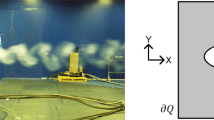Abstract
Two-dimensional viscous flows around obstacles are considered in an unbounded liquid. The basic idea developed in Part 1 is further extended from a single body to multi-body configurations. This idea follows from the formulation by Quartapelle and Napolitano (AIAA J. 21:991–913, 1983) who proposed computation of the force and moment in incompressible viscous flow without explicitly calculating the pressure. The principle is the projection of Navier–Stokes equations on a set of functions. Surprisingly, these functions have a precise meaning in potential theory. They are the solutions which lead to the added masses and added moment of inertia for the potential flow around the studied arrangement of obstacles. By revisiting this problem, a general identity of the full coupled matrix of added masses and added moment of inertia is formulated. To this end conformal mappings for multi-body configurations are used. Robustness of the proposed algorithms is tested and illustrated. The obtained potential solution is merely a mathematical solution and it does not allow to describe the actual potential flow since the circulation is not accounted for. However, its interest is crucial for implementing the projection technique developed by Quartapelle and Napolitano. The interest of such a method is two-fold. Firstly, it provides a way of computing the force without explicitly calculating the pressure. Consequently and secondly, it offers an alternate way to validate the computation of the loads. In effect, these loads are always available from a direct integration of the Cauchy stress tensor (pressure plus friction). It is worth mentioning that the present technique allows an a posteriori computation of the pressure.
Similar content being viewed by others
References
Quartapelle L and Napolitano M (1983). Force and moment in incompressible flows. AIAA J 21: 911–913
Etienne S (1999) Contribution a la modélisation de l’écoulement de fluide visqueux autour de faisceaux de cylindres circulaires. PhD Thesis, University of Aix-Marseille 2
Crowdy DG (2006). Calculating the lift on a finite stack of circular aerofoils. Proc Roy Soc A 462: 1387–1407
Kochin NE, Kibel IA and Roze NV (1964). Theoretical hydromechanics. Intersciences Publishers, New-York
Lavrentyev M and Shabat B (1977). Méthodes de la théorie des fonctions d’une variable complexe. Edition du MIR (in French), Moscou
Venkatesan SK (1985). Added mass of two cylinders. J Ship Res 19(4): 234–240
Lagally M (1929). Die reibungslose Strömung im Aussengebiet zweier Kreise (English translation: the frictionless flow in the region around two circles). ZAMM 9(4): 299–305
Ives DC (1976). A modern look at conformal mapping including multiply connected regions. AIAA J 14(8): 1006–1011
Halsey N (1979). Potential flow analysis of multielement airfoils using conformal mapping. AIAA J 17: 1281–1288
Suddhoo A (1985) Inviscid compressible flow past multi–element airfoils. PhD Thesis, University of Manchester
Prosnak WJ (1987). Computation of fluid motions in multiply connected domains. Wissenschaft + Technik, Brau Karlsruhe
Scolan Y-M, Faltinsen O (1993) Numerical prediction of viscous flows around multi-bodies by a Vortex Method. Proc. 6th international conference on numerical ship hydrodynamics, Iowa, USA, pp 439–453
Basset AB (1888) A treatise on hydrodynamics. Cambridge University Press
Wegmann R (1986). An iterative method for the conformal mapping of doubly connected regions. J Comput Appl Math 14(1–2): 79–98
Luchini P and Manzo F (1989). Flow around simply and multiply connected bodies-a new iterative scheme for conformal mapping. AIAA J 27(3): 345–351
Theodorsen T and Garrick IE (1933). General potential theory of arbitrary wing sections. NACA Rept. 452: 177–209
Chu JH, Choi DH and Kim MU (1999). Two-dimensional viscous flow past a circular arc. Fluid Dyn Res 25(5): 275–291
Newman JN (1977). Marine hydrodynamics. MIT Press, Cambridge
Scolan Y-M (2005). Some aspects of the potential flow around rotating bodies. Comptes Rendus Mecanique 333(6): 487–492
Warchawski SE (1945). On Theodorsen’s method of conformal mapping of nearly circular regions. Quar J Appl Math 3(2): 12–28
Kober H (1957) Dictionnary of conformal representations. Dover Publications, Inc
Nehari Z (1975). Conformal mapping. Dover Publications, New York
Newman JN (1979). Added moment of inertia of two-dimensional cylinders. J Ship Res 23: 1–8
Protas B, Styczek A and Nowakowski A (2000). An effective approach to computation of forces in viscous incompressible flows. J Comput Phys 159(2): 231–245
Pan LS and Chew YT (2002). A general formula for calculating forces on a 2-d arbitrary body in incompressible flow. J Fluids Struct 16(1): 71–82
Author information
Authors and Affiliations
Corresponding author
Rights and permissions
About this article
Cite this article
Scolan, YM., Etienne, S. On the use of conformal mapping for the computation of hydrodynamic forces acting on bodies of arbitrary shape in viscous flow. Part 2: multi-body configuration. J Eng Math 61, 17–34 (2008). https://doi.org/10.1007/s10665-007-9159-1
Received:
Accepted:
Published:
Issue Date:
DOI: https://doi.org/10.1007/s10665-007-9159-1




